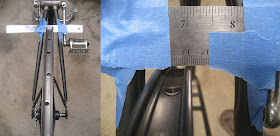For Fixed Gear Conversions you have 4 options
1. Most Expensive, but Easy, Safe, and Pretty: Buy a replacement rear wheel with a wheel that has a track/fixed hub or flip flop hob (has both fixed gear side and single speed coasting side)
2. Easy, but Ugly:You can just keep your old multi speed cassette on, but remove the derailleur. Your chainline probably won't be perfect but should be close.
3. Some Work, Sorta Ugly: Take your old rear cassette and remove the outside lock ring. Then remove all the different gear sprockets. Just pick the rear sprocket that you want and put on spacers instead of the other sprockets so the chain line is straight with the front chain ring.
4. Good Amount of Work, Not the Safest but Pretty: (This is the method I chose) Unscrew the whole rear cassette from the hub. The hub will only have the normal right-handed threads for the cog and not the additional reverse threads for the lockrings used on track/fixed hubs. Warning: There is the possibility that the sprocket on a hub without a lockring will unscrew while back pedaling. Therefore it is recommended to still have brakes on a fixed-gear bicycle using a converted freewheel hub in case the cog unscrews while back pedaling. It is also advisable to use a thread sealer for the cog and bottom bracket lockring. The rotafix (or "frame whipping") method may be helpful to securely install the sprocket.
You will have to buy a separate sprocket that has a thread that fits on to the hub. I suggest buying a name brand cog as I have read reviews that the cheap ones have weak threads that will strip. I bought a Surly cog off ebay for $20 shipped. Above is the easy part.
You will have to buy a separate sprocket that has a thread that fits on to the hub. I suggest buying a name brand cog as I have read reviews that the cheap ones have weak threads that will strip. I bought a Surly cog off ebay for $20 shipped. Above is the easy part.
Next you will need to add spacers to your rear axle until the front chain ring lines up directly with the new rear sprocket. This is a bit of trail and error. Now you have a nice chain line that will run smoothly, reduce wear and reduce the chance of the chain falling off.
The most difficult part is dishing then truing the rear wheel. What this means is that when you are looking at your rear spokes they will be longer on one side of the hub than the other. This is done to offset the hub because the rear cassette takes up a lot of room along the axle. And the tire needs to be centered between the rear stays to work with rear brakes. (If you don't have rear brakes the rear wheel doesn't have to be in the exact center, but the bike will run more efficiently without uneven wear on the tires). See the picture below for how it will look before you re-dish and true the wheel.

On to re-dishing, meaning to move the tire rim in relation to the hub. The spokes will need to be loosened on the short side (cassette side) and tightened on the long side. The spokes can be adjusted 2 ways; 1. Using a spoke wrench on the inner part of the rim or 2. (my preferred method) by removing the tire and inner-tube and adjusting the spokes with a screwdriver. The spoke wrench method is nice for trueing and small adjustments but the screwdriver method is much easier for large adjustments like re-dishing a converted fixed gear wheel.
Start at the inner-tube valve stem and work your way around. Apply some light oil or lube in all spoke screw holes to make sure you don't break a spoke because that is a game changer. Begin by loosing with 1 revolution then move to the next spoke and tighten 1 revolution. This process will take a while so keep going around until the rim is centered over the hub.
Once you have re-dished the wheel now you must make it true. Truing just means to make sure the tire runs smoothly with no wobble. The best way to do this without an expensive truing stand is to set up a ruler between the rear stays. Now adjust the spokes one by one so they are centered on your ruler. I find it the easiest to pick one side and make sure that side of the rim stays at that point (see tape edge pictured above or watch this video on truing bike wheels). This takes a lot of patience, but if you succeed you will have accomplished one of the most difficult skills of a bike mechanic.
Good luck.
The most difficult part is dishing then truing the rear wheel. What this means is that when you are looking at your rear spokes they will be longer on one side of the hub than the other. This is done to offset the hub because the rear cassette takes up a lot of room along the axle. And the tire needs to be centered between the rear stays to work with rear brakes. (If you don't have rear brakes the rear wheel doesn't have to be in the exact center, but the bike will run more efficiently without uneven wear on the tires). See the picture below for how it will look before you re-dish and true the wheel.






No comments:
Post a Comment